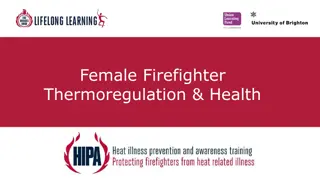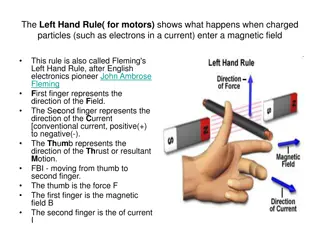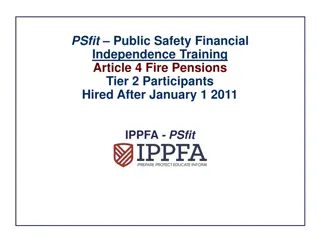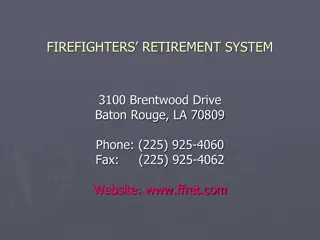Comprehensive Hand Tools and Utilities Training for Firefighters
This training program focuses on equipping firefighters with the knowledge and skills to identify, use, and maintain hand tools and forcible entry equipment. It covers the proper handling of various tools, understanding gas and electrical emergencies, and sizing up scenes effectively. Practical demonstrations, tool familiarization, and safety discussions are key components of the training. Additionally, members learn about saw blades, thermal imaging cameras, and small CO meters for firefighting operations.
Download Presentation

Please find below an Image/Link to download the presentation.
The content on the website is provided AS IS for your information and personal use only. It may not be sold, licensed, or shared on other websites without obtaining consent from the author.If you encounter any issues during the download, it is possible that the publisher has removed the file from their server.
You are allowed to download the files provided on this website for personal or commercial use, subject to the condition that they are used lawfully. All files are the property of their respective owners.
The content on the website is provided AS IS for your information and personal use only. It may not be sold, licensed, or shared on other websites without obtaining consent from the author.
E N D
Presentation Transcript
Hand Tools / Utilities / Forcible Entry Objective: To have members properly identify and use the various hand-tools. Members must also know the location of tools on the apparatus. Have members familiarize themselves with gas and electrical emergencies and what is the CFD approach to these types of calls. Have members know what is expected of them when sizing up at scene or emergency.
Hand Tools Lecture: Identify each of the tools on display and discuss the components of each tool and the material that they are manufactured from. Also, they must know their location on the apparatus. Demonstrate how to carry and use each of the tools. Let all members handle each tool. Review the safety factors that apply with each tool. Discuss the use and various fuel mixtures for each power saw. Have each member change the blades and they should all be able to start each saw. Discuss the use of the power fans and work to establish an external power (from our apparatus). Review the necessary adapters and their color-codes, Discuss the direction of airflow from the fans and establish a light source in the area of the operation. Review care and maintenance of all tools (wood & fiberglass handles, cutting edges and metal surfaces)
Vocabulary Set of Irons Combination of a flat-headed axe and a Halligan tool. This is used for forcible entry.
Vocabulary Saw Blades Carbide tipped (12 or 24 teeth) - used for wood, light roof material (such as shingles etc) Aluminum Oxide -round edge abrasive disc used for metal cutting operation Silicon Carbide round edge abrasive disc used for concrete cutting operation
Vocabulary K-Tool Steel two sided tool used to remove lock cylinders from building doors (through the lock method). One side is shaped like a K . This slides over the cylinder with a tapered edge. The other side has a place to position the adz end of the Halligan that can be tapped with the flat-headed axe to force the tapered end down onto the cylinder.
Vocabulary Thermal Imaging Camera A thermal imaging camera is a type of thermographic camera used in firefighting. By rendering infrared radiation as visible light, these cameras allow you to see areas of heat through smoke, darkness, or heat-permeable barriers. They are constructed using heat- and water-resistant housings, and ruggedized to withstand the hazards of fireground operations.
Vocabulary Small CO Meters On first due engines. This meter is used to measure levels of CO (display will read in PPM). An audible alarm is set to go off at 35ppm
Vocabulary Flat Head Axe Often used as a striking tool (6 to 8 lbs.) Pick Head Axe Can be used for puncturing or picking (6 to 8 lbs.)
Vocabulary Circular Saw Used for ventilation and or forcible entry Chain Saw Used for ventilation, building collapses and brush areas
Vocabulary Halligan prying and forcible entry Rabbit Tool Used for forcible entry (had pump spreader) Pike Pole Pushing/pulling, but not directly at yourself
Vocabulary Bolt Cutter Used for cutting locks, chains & chain link fences. Not to be used to cut wire. Electrical Equipment Review code of adapters Tool Pouch Review tool in pouch Duck Bill Forcible entry (lock breaker)
Utilites Gas and electric emergencies (signal 23 s) can be problems for us and by standers. Full turn out gear is required. SCBA is also required for gas emergencies. Electrical problems We do not normally pull meters (it may not also kill all the electricity). We should turn off all the circuit breakers including the master circuit breaker. Stay away from the transmission lines; they may carry 69k to 139k volts. Gas problems Park 200 feet away from the leak (and yes you may have to walk). Remember natural gas goes up in the air and propane gas stays low to the ground. Check location of water supply and evacuate area as required. The Gas turn off can be found in front lawn (look for tags on the front of building where gas lines enter). Review tools that can be used to turn off gas. Carbon Monoxide This is odorless & colorless gas. Discuss Department SOP for type of response (2 companies so we will have 2 meters on scene to check the first due meter). Turn meter on outside the building. Conduct a check around the CO alarm, ovens, and stoves, heating systems, hot water systems, dryers, fireplaces and chimney. Report the CO meter reading to the OIC and prepare the CFD Carbon Monoxide Alarm Emergency Report.
Size-Up Size-up is a job for all firefighters. You may see something that was missed by the officers or other firefighters. Part of the size- up will be in the initial report made by the OIC. This helps the OIC plan his objectives for responding to the emergency. It may also help to prevent incident acceleration.
Size-Up Items to be included in your size-up: 1. 2. 3. 4. 5. 6. 7. 8. 9. 10. 11. 12. 13. 14. 15. 16. 17. 18. 19. 20. 21. Receipt of alarm by the dispatcher Type of call responding signal (12, 13, 14, 23 etc.) Computer printout Phone or automatic alarm (signal 13) Time of day and day of week Weather condition Radio communication of 1st arriving Building construction type of roof, residential, commercial, etc. Occupied (number of people) or not Multiple mail boxes Cars in driveway Hydrant location Hazmat Utilities where located Color of smoke Location & size of fire Position of hand lines, ladders & apparatus Indication of forcible entry before we arrived Arson awareness Life hazards (by standers & firefighters) Collapse indicators
Forcible Entry Objective: To teach the trainees the proper method of the use of forcible entry tools and how to apply them with according to the CFD procedures.
Hands-On Evolution 1 - K-Tool: Use the K-Tool to open the simulator door. Demonstrate how to pull the lock cylinder with a set of irons (flat head axe and a Halligan) along with the K-Tool. Once the lock is pulled, demonstrate how to unlock the slide bolt with the K-Tool. Evolution 2 Set of Irons Using the training door (in training facility), demonstrate the proper use of how to use a set of irons to force both an inward and outward opening doors. Be sure to show if there is more than one lock on the door and how to place the Halligan between both locks. Evolution 3 Rabbit Tool: Demonstrate the use of the Rabbit tool on an inward-opening door. Be sure to stress that you never position yourself in front of the lock leveraging forced to the front. The bolts may fly out at a heavy force when broken. Evolution 4 Misc. Tools: Demonstrate how to use the bolt cutters, Duckbill and K-12 saw to open up pad and hockey puck locks. Also, demo. The saw and show how to open up roll down gates. Be sure to make a point in showing the trainees how to stay low and control the door when forcing it open. Also clearing out any cross bars and chock open all doors so they won t close behind you. Evolution 5 Breaking Glass: Demonstrate the proper way on how to break glass in both doors and windows. Show the trainees the correct angle of holding the tools so the glass will fall away from the firefighter. Be sure to tell them that all glass must be totally cleaned out of the window or door (even the window cross members and panic bar on door). Evolution 6 Breaching Walls: Breaking walls sometimes may be faster and more efficient than working the door lock. If going through a partition wall (dry or plaster wall), pick a section without electric plugs or switches. Punch a hole with a forcible entry tools. Brick or concrete block walls can be broken with a maul, circular saw or air chisel. Make a triangular shape cut in the wall.























